March 3, 2021
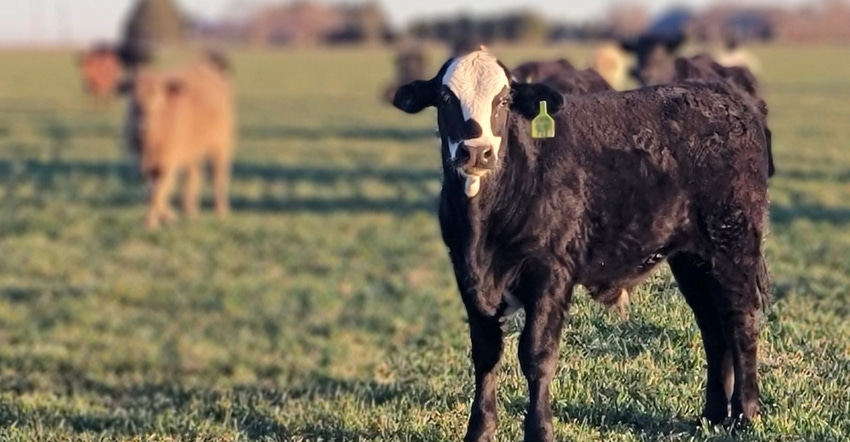
February’s Texas cold snap dropped temperatures to as low as -12 degrees Fahrenheit in the Panhandle to mid-single digits as far south as the Austin region. Some locations, including Tyler, set all-time record lows, according to a recent Texas AgriLife Extension Texas Row Crops Newsletter.
Lubbock recorded -6 degress, only the third time below 0 degrees since 1980, and the coldest since 1963, reported Calvin Trostle, Texas AgriLife Extension agronomist, Department of Soil & Crop Sciences, Lubbock. "Furthermore, the temperature was below freezing for a full seven days at Lubbock (and much of that below 10 degrees) allowing temperatures to potentially penetrate any canopy and into the ground."
The Central Texas wheat crop was at some growth stage of jointing, especially the early maturity varieties, reported Fernando Guillen-Portal, state Extension small grains specialist, Dept. of Soil & Crop Sciences, College Station. "We believe this wheat was the most susceptible to injury as the growing point would be at or above the soil surface. You can best tell by looking for hollow stems. If you find a hollow stem, then the growing point is above the hollow area."
Other Texas small grains also were susceptible to the freezing conditions. "Rye and triticale are generally more cold tolerant than wheat, but oats and barley less so," Trostle added.
See, Recent storm freezes Texas citrus
Trostle and Guillen-Portal listed key points to consider regarding the pronounced freeze on Texas wheat and other small grains. Their information is derived from the “Wheat Freeze Injury in Texas” document, which covers the conditions and effects of a prolonged freeze on wheat in the tillering stage and at other growth stages.
Key Considerations
Temperatures were below freezing for six to seven days over much of Texas wheat.
At the onset of the freeze, no known High Plains wheat was close to jointing and none likely in the Rolling Plains, either, which lessens injury potential. South, Central, and possibly Northeast Texas might have some wheat that was beyond the tillering stage (jointing, or further development).
Essentially all wheat varieties in the High Plains and Rolling Plains are grown several hundred miles to the north, so they do have cold tolerance.
The fact that it had been so warm might make wheat more susceptible to freeze. For example, Lubbock tied a record high of 80 degrees on Super Bowl Sunday, Feb. 7.
If snow was received in the early part of the freeze and was not blown off the field, then the snow can help protect the wheat. This cold protection is common for winter wheat in the Central Great Plains. This protection is good, and there is moisture for the wheat crop when it warms up.
Additional considerations:
The document suggests temperatures below 12 degrees for at least two hours could cause some damage (leaf yellowing, leaf tip and leaf tip burn, silage odor, bluish color). These symptoms have only slight to moderate impact on yield. We do not think 12 degrees is that important as much winter wheat in the High Plains is well below this temperature in different years.
Low temperature and its duration, soil moisture, and wind can influence injury potential. Soils that are very dry enable the cold to penetrate further into the soil to the crown. This is more likely in the drought areas of Texas, especially in the High Plains region where the drought monitor shows some extreme and exceptional drought. If soil moisture is high, then the foliage likely has a high moisture content and is more susceptible to freeze damage. In Texas, which factor in the recent freeze was more important? For North Texas, the Rolling Plains, the High Plains, and possibly the Concho Valley, the importance of the growing point—still below the soil surface—is much more important than possible loss of leaves due to freeze and burn.
Leaf burn usually does not have a great impact on yield potential at the current stage of growth for most Texas wheat. The plants will develop new leaves. This may be less so for wheat in South Texas. But even there, if much of the foliage is lost, and even a few growing points, the wheat can compensate with new tillers. Inspect the base of the wheat plant (crown) below the soil line. If it is turgid and green, there is no reason for concern.
Grazed, drought-stressed wheat is a major concern in the northern and High Plains. Grubbing the wheat down too much will curtail its ability to recover if moisture becomes available. This is a case of “less is more.” Less grazing—hopefully, cattle can be moved off the wheat for a couple of weeks. (Do you have a place to go with them?) Then following moisture and jointing, the cattle can be returned to the field to catch the burst of early spring growth.
See photo gallery, Winter storm 2021
Regional Updates
AgriLife Extension specialists provide the following regional wheat-status updates:
Central Texas (Hillsboro, Waco)
Tyler Mays, AgriLife Extension agent-IPM, Hill & McLennan counties
Winter Storm Uri hit the Central Texas area with severe cold temperatures. Some areas in the region got as low as -2 degrees degrees. Thus, I anticipated severe freeze damage in wheat. Field scoutings in the Hill County and northern McLennan counties showed a varying degree of damage from negligible to severe leaf burn and growing point injury. The snow received in the area early in the storm, along with most producers having finished nitrogen topdressing the week before, prevented further damage. An assessment on the degree of injury at the growing point of the plant indicated only 10% of plants with growing point damage (Figures 1 and 2). Scouting a 1,700-acre field of wheat indicated:
79% of acres suffered minor damage with just the tips of the upper leaves being burned.
15% suffered severe leaf burn but no damage to the growing points.
6% suffered severe leaf burn with some growing point damage.

Figure 1. Effect of freezing temperatures observed during Uri storm on growing point in the plant. Left, healthy, and right, dead growing point. (Photos courtesy of Texas AgriLife Extension)

Figure 2. Overall view of leaf burn damage caused by the freezing front. Left, hard red winter wheat variety WB Cedar. Right, soft red winter wheat variety TA8861.
Central Texas (College Station, Austin)
Fernando Guillen-Portal, State Extension Small Grains specialist, TAMU Dept. of Soil & Crop Sciences, College Station
Winter wheat fields around College Station were exposed to freezing temperatures Feb. 12 through Feb. 19 (average of 26 degrees). Minimum temperatures within that period ranged from 6 degrees to 30 degrees. Freezing conditions caused leaf burn damage to a varying degree. Given that wheat was still at the vegetative stage and was covered by at least 4 inches of snow Feb. 10, freeze damage might not be of significance. Preliminary observations at 10 days after the freeze on a winter wheat variety test plot at the TAMU Farm Lab (College Station) indicated a varying degree of sensitivity to leaf burn damage among varieties (Tables 1 and 2, Figure 3). It is likely these differences in leaf damage relate to differences in variety growth rate, the most affected ones being the early maturity. Overall, early observations suggest levels of damage on South Texas wheat caused by this unprecedented front were minimal.
Table 1. Leaf burn damage caused by freezing temperatures in hard red winter wheat genotypes at the TAMU farm near College Station, TX (Feb 24, 2021).

†Oklahoma State University
Table 2. Leaf burn damage caused by freezing temperatures in soft red winter wheat genotypes at the TAMU farm near College Station, TX (Feb 24, 2021).
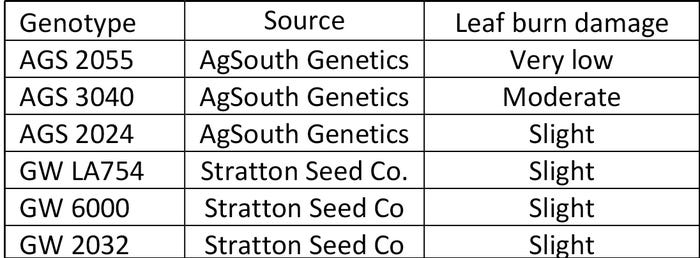
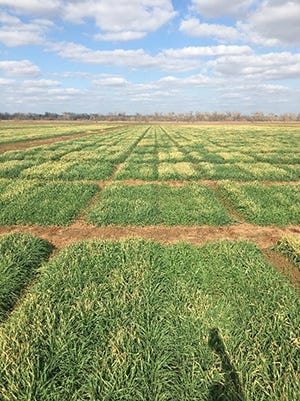
Figure 3. Varying leaf burn damage observed Feb. 24, 2021, in a field trial including hard red and soft red winter wheat genotypes planted Nov. 11, 2021, at the College Station Farm Lab.
Northeast Texas
David Drake, AgriLife Extension agent-IPM, Hunt County
Temperatures have returned to normal and the snow melted. A common question: “Are my fall planted crops damaged?” The short answer is probably not. There was a gradual hardening off by low temperatures. During the coldest temperatures (-1 or -2 F°) there was an insulating blanket of snow. Lastly the wheat and other small grains should have still been in the vegetative stage where they are more cold tolerant. Some oat plants that are less winter hardy have freeze-burned leaves, but the crowns are still green (Fig. 4). Annual ryegrass, barley, wheat, triticale, and cereal rye all should be fine. The more cold tolerant species are listed last.
South Plains
Calvin Trostle, professor and Extension agronomist, TAMU Deptarment of Soil & Crop Sciences, [email protected]
Wheat appears to not have been significantly damaged. The leaf burn observed is typical during winter (Fig. 5). On the fields I looked at no more than 20% of leaf matter has been lost to freeze burn. All wheat appears fine at the crown. Some fields are showing “pseudo” stems, which are rolled leaves. This is a precursor to jointing and the hollow stem stage (Fig. 6). Once the first few hollow stems appear, if cattle are grazing but grain harvest is planned then cattle need to be removed. Most of the wheat is at Feekes 4 growth stage (beginning of erect growth). For Feekes growth stages, see https://wheatfreezeinjury.tamu.edu/files/Growth%20Stages%20of%20Wheat.pdf The growing point is below the soil surface and insulated from the coldest temperatures.
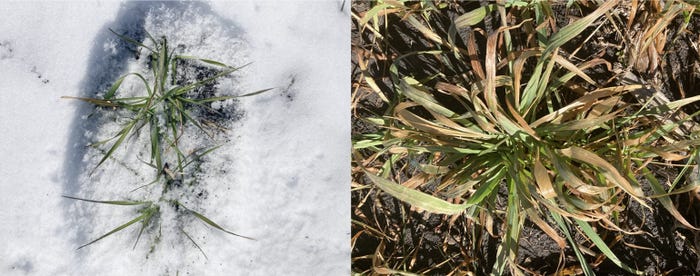 Figure 4. Left, wheat partially insulated by snow. Right, oats with upper leaves damaged by cold temperatures but plant tissue in the center above the crown is still green. (Hunt Co., Texas, Feb. 2021, photo courtesy of Texas AgriLife Extension)
Figure 4. Left, wheat partially insulated by snow. Right, oats with upper leaves damaged by cold temperatures but plant tissue in the center above the crown is still green. (Hunt Co., Texas, Feb. 2021, photo courtesy of Texas AgriLife Extension)
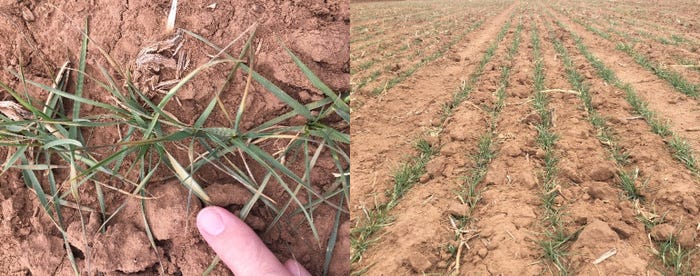
Figure 5. Left, modest leaf burn of Nov. 8 planted wheat (Lubbock County). Some leaves have curled and are dried out. The core of the plant at the soil line is green and undamaged. Right, dryland field with light leaf burn but otherwise healthy.
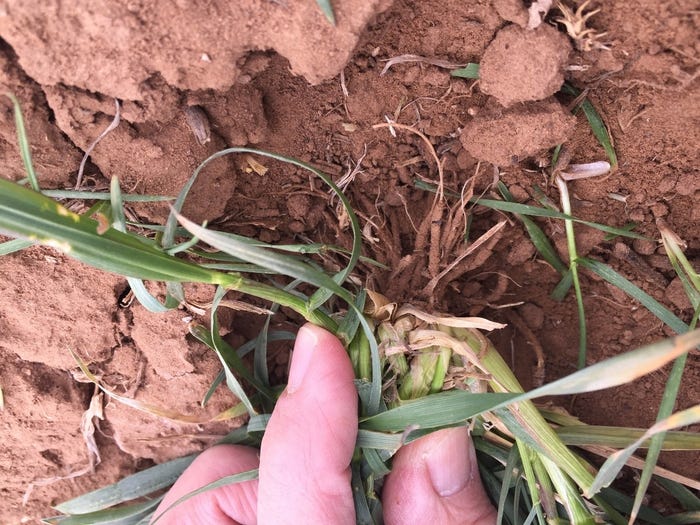
Figure 6. Above, more advanced dryland wheat growth showing a ‘pseudo’ stem, which consists of rolled leaves. This is not jointing though it may be a week or so away (Lubbock Co.).
See, Winter Storm Uri: Initial Texas ag losses exceed $600 million
Panhandle
Jourdan Bell, Extension agronomist, Amarillo
I have checked wheat at the Bushland Research Farm. Fortunately, wheat is at only Feekes 4 to Feekes 5 (strong erect growth, presence of pseudo stems) so it was less susceptible to freeze injury than if it was at a more mature growth stage. We do have leaf burn, but the crown looks good. However, dryland and grazed fields in the Bushland area exhibit greater injury as noted for the South Plains. Essentially, if the wheat condition was poor prior to freezing temperatures, drought stress and over grazing compounded freeze injury. Fortunately, the snow was received before we dropped to subzero temperatures as low as -15 degrees. The snow stabilized soil temperatures (Figure 7) and provided a blanket that protected the wheat from subzero air temperatures. It is amazing that although during and after the lowest air temperatures, soil temperature at the 2-inch depth never dropped below 34 degrees.
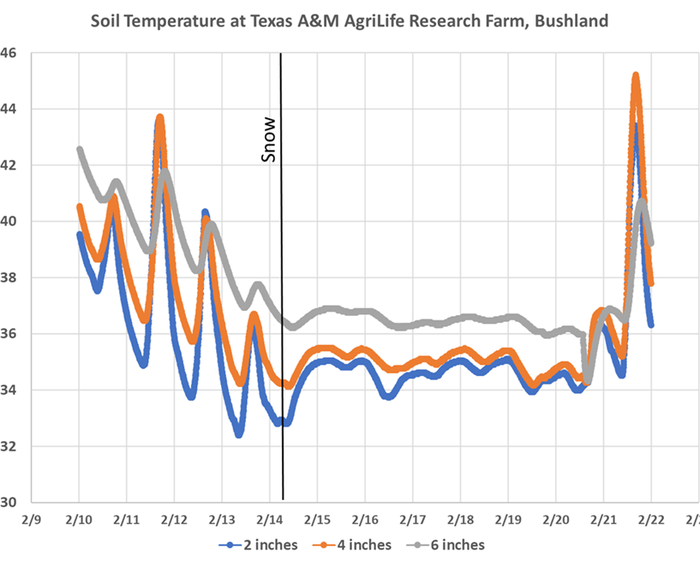
Figure 7. Soil temperatures at the 2-inch depth at the Texas A&M AgriLife Research Farm, Bushland, remained above freezing during the entire winter blast from Feb. 13 to Feb. 21. This protected wheat crowns. The lowest air temperature was -15 degrees the morning of Feb. 15. Once snow fell, the 2-inch soil temperature rose 2 degrees.
Read more about:
Winter Storm UriAbout the Author(s)
You May Also Like






